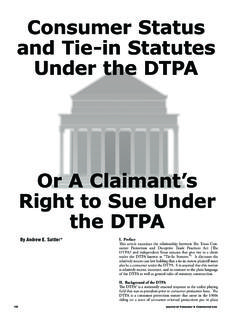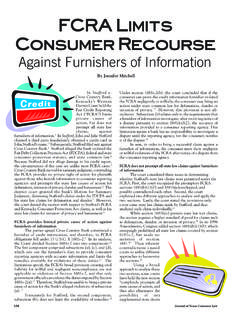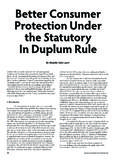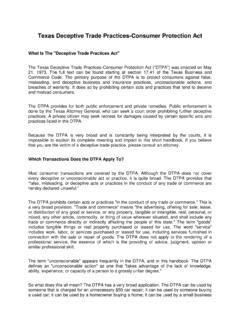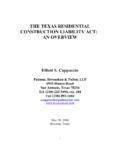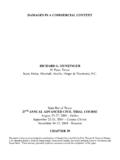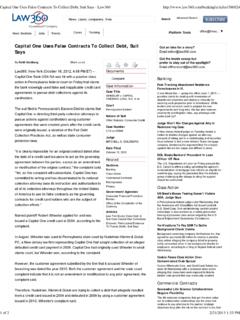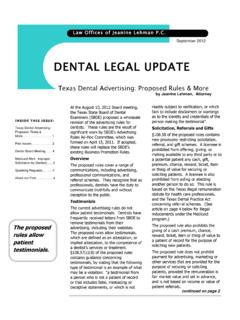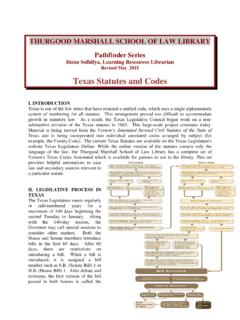Transcription of The Texas Deceptive Trade Practices Act 2005
1 74 Journal of Texas Consumer Law2005I. INTRODUCTIONP rior to 1973, Texas consumer law could be summed up in two words, caveat In 1973, however, the Texas Legislature enacted the Texas Deceptive Trade Practices Consumer Protection The DTPA, as it soon became known, was quickly recognized as one of the foremost consumer protection statutes in the country. Its broad applicability, no-fault liability, and attractive remedial provisions, encourage attorneys to represent consumers. Courts at all levels followed the mandate of section to liberally interpret the DTPA consistent with its stated purpose, which was to protect consumers against false, misleading, and Deceptive business Practices , unconscionable actions, and breaches of warranty and to provide effi cient and economical procedures to secure such protection.
2 3 This mandate, coupled with the language of section making it clear that the remedies provided by the DTPA are cumulative to any other procedures or remedies provided for in any other law,4 resulted in an extremely favorable climate for plaintiffs and plaintiffs attorneys. But sometimes, too much of a good thing can turn bad. By the early 1990s, the DTPA had become a powerful tool, utilized successfully by consumer attorneys to combat nearly all forms of misrepresentation, deceit, and fraud in the marketplace. The DTPA was also successfully employed, however, in nearly all forms of civil litigation. Our state s consumer protection statute was the preferred basis for litigation involving multi-million dollar commercial transactions,5 personal injury arising out of an assault in an apartment complex,6 professional malpractice,7 and even the traditional slip and fall liability Actual damages often reached seven fi gures, additional damages were common, and attorneys fees were the same time attorneys and courts were The Texas Deceptive Trade Practices Act STILL ALIVE AND WELL Richard M.
3 Alderman*embracing the liberal provisions of the DTPA, the political climate in Texas was becoming much more conservative. Gradually, tort reform became the phrase of the day. The tort reform movement began in earnest in Texas in the By the end of the 1980s, Texas had enacted substantial changes in the law, and had even attempted to reduce the damages recoverable under the DTPA in non-traditional consumer But the real reform would come in 1995, when the Republican controlled legislature enacted a broad reform agenda that included wholesale amendments to the With the stated goal of leveling the playing fi eld, the legislature substantially amended the Act in an attempt to limit the amount of damages, preclude application of the DTPA to traditional tort suits, exempt certain large transactions.
4 And make it easier for defendants to force a settlement and recover attorneys fees for frivolous claims. The 1995 amendments clearly limited the scope of the DTPA and the amount of damages that may be recovered, and gave defendants additional opportunities to settle and a greater likelihood of recovering their attorneys fees for defending a DTPA claim. The 2003 session of the legislature saw a second major round of tort reform legislation that, although not directly dealing with the DTPA, placed limits on recovery against certain defendants, particularly those in the residential construction The goal of the reformers was to limit the applicability and effectiveness of the DTPA. No one can argue that they did not succeed.
5 The extent of their success, however, is subject to debate. It is clear that the DTPA has been weakened. In absolute terms, the Act does not provide anywhere near the benefi ts it did for consumers. But an analysis in absolute terms is misleading. To truly evaluate the effectiveness of the DTPA as a tool for consumer attorneys, it must be measured in relative terms. While the DTPA was being amended and its 75 Journal of Texas Consumer Lawapplication limited by the courts and legislature, other available causes of action were being similarly reviewed, and reduced. Tort claims have been subject to even greater reform than the DTPA. Available defendants in tort and contract suits are reduced, damages are limited, comparative responsibility is strengthened, and punitive damages are sharply limited in both availability and amount.
6 In contrast to claims based in tort or contract, the DTPA still provides a no-fault standard of recovery, the lowest causation standard, the most liberal standard for the award of exemplary damages, and mandatory attorneys fees. In other words, relative to other available causes of action, the DTPA is still alive and well. II. APPLICABILITY: PROPER PARTY PLAINTIFF CONSUMERP erhaps the most signifi cant even in the past decade of DTPA reform is a change that was not made. The defi nition of consumer has not been changed since the 1983 amendment,14 which added the business consumer exception. Under section (4) a consumer is:an individual, partnership, corporation, this state, or a subdivision or agency of this state who seeks or acquires by purchase or lease, any goods or services, except that the term does not include a business consumer that has assets of $25 million or more, or that is owned or controlled by a corporation or entity with assets of $25 million or other words, the DTPA still applies to a broad range of individuals and businesses.
7 It includes any individual purchasing any thing, as well as the vast majority of businesses buying for a business purpose. More signifi cantly, because the defi nition has remained the same for 21 years, there is a large body of case law interpreting it and upon which attorneys can rely. 1. RequirementsBasically, to be a consumer, a qualifi ed entity must seek or acquire, by purchase or lease, goods or Note that there are three requirements that may be satisfi ed with alternatives in each category. For example, a consumer may seek by purchase goods; or, acquire by purchase services; or, acquire by purchase goods. Because of the signifi cance of this defi nition (if you are not a consumer you may not use the Act), it has been one of the most litigated sections of the Act.
8 The focus of the litigation has been the meaning of the terms seek or acquire, purchase or lease, and goods or services. a. Seek or AcquireAssuming that the party asserting a claim under the Act is an entity within the scope of the defi nition of consumer, the next question is did that entity seek or acquire? Note that it is only necessary that the entity claiming consumer status prove that it either sought or acquired. In most cases, it is simple to determine whether an entity has sought or acquired something. For example, if someone buys something he or she has acquired it. If someone is in the process of buying something, he or she is seeking it. There is no requirement, however, that there be a contractual relationship, a contract, or a payment.
9 For example, in Martin v. Lou Poliquin Enterprises, Inc.,17 Martin contacted a company to place an advertisement in the local yellow pages. The company failed to properly place the ad and violated the DTPA. The company defended by asserting that because Martin did not pay for its services, there was no consideration and, therefore, Martin was not a consumer. The court held that the DTPA does not require the transfer of consideration. An entity is a consumer if it seeks to purchase goods. The court found the test to be whether the consumer had a good faith intention to purchase, as well as the ability to noted above, in most cases it is simple to determine if someone has acquired something. For example, anyone who buys something and takes possession of it has clearly acquired it.
10 The courts, however, have held that a good may be acquired by someone who actually is not the owner of the good or has taken possession of it. The test is whether the objective of the transaction was to benefi t the individual claiming consumer status. In Wellborn v. Sears, Roebuck & Co.,19 a mother brought a DTPA claim on behalf of her deceased son. The claim was based on a defective garage-door opener, bought by the mother for her home. The court held that although there was no contractual relationship between the son and the seller, the son acquired the garage door opener and the benefi ts it provided. The son acquired the garage door opener when it was purchased for his benefi show that goods or services were purchased for someone else s benefi t, and confer upon that person consumer status, it is necessary to show more than mere use of, or ben-efi t from, the goods.
